Insights into Flood Wave Propagation in Natural Streams as Captured with Acoustic Profilers at an Index-Velocity Gaging Station
Abstract
:1. Introduction
2. Principles and Practice of Conventional Monitoring Methods
3. Index-Velocity Method Applied to an Actual Gaging Station
3.1. Study Site
3.2. Monitoring Datasets
3.3. Substantiation of the Hysteretic Features in the Annual Datasets
3.4. Substantiation of the Hysteretic Features in Individual Event Datasets
3.5. IVRC Performance during Flood Wave Propagation
4. Discussion
5. Conclusions
- (a)
- Hysteresis occurring at monitoring sites located in low-gradient channels exposed to flood waves is significant, being commensurate with the site and flood wave characteristics;
- (b)
- Unsteady flows produce a non-unique relationship between any two of the flow variables and an out-of-phase flow hydrographs during the flood wave propagation;
- (c)
- The index-velocity method can more aptly capture hysteresis compared with the stage-discharge method;
- (d)
- If a discharge monitoring method capture hysteresis, it is implicit that it can also distinguish the peak sequencing and vice versa.
Author Contributions
Funding
Data Availability Statement
Acknowledgments
Conflicts of Interest
References
- USGS. A history of the Water Resources Branch, U.S. Geological Survey; Follansbee, R., Ed.; Volume I, from Predecessor Surveys to 30 June 1919; U.S. Geological Survey: Denver, CO, USA, 1994.
- Jain, S.; Lall, U. Magnitude and timing of annual maximum floods: Trends and large-scale climatic associations for the Blacksmith Fork River, Utah. Water Resour. Res. 2000, 36, 3641–3651. [Google Scholar] [CrossRef]
- Holmes, R.R. River rating complexity. In Proceedings River Flow Conference; Taylor & Francis Group: St. Louis, MO, USA, 2016; ISBN 978-1-138-02913-2. [Google Scholar]
- Saint-Venant, A.J.C. Théorie du mouvement non permanent des eaux, avec application aux crues des rivières et a l’introduction de marées dans leurs lits. Comptes Rendus L’académie Sci. 1871, 73, 147–154, Discussion 237–240. [Google Scholar]
- Chow, V.T. Open Channel Flow; McGrow Hill: New York, NY, USA, 1959. [Google Scholar]
- Hunt, A.E. The Behaviour of Turbulence in Unsteady Open Channel. Ph.D. Thesis, University of Canterbury, Christchurch, New Zealand, 1997. [Google Scholar]
- Henderson, F.M.; Open Channel Flow. Macmillan Series in Civil Engineering; Macmillan Company: New York, NY, USA, 1966; p. 522. [Google Scholar]
- Muste, M.; Lee, K.; Kim, D.; Bacotiu, C.; Oliveros, M.R.; Cheng, Z.; Quintero, F. Revisiting hysteresis of flow variables in monitoring unsteady streamflows. J. Hydraul. Res. 2020, 58, 867–887. [Google Scholar] [CrossRef]
- Ponce, V.M. Development of Physically based Coefficients for the Diffusion Method of Flood Routing; Contract No. 53-3A75-3-3; U.S. Soil Conservation Service: Lanham, MD, USA, 1983.
- Ferrick, M.G. Analysis of River Wave Types. Water Resour. Res. 1985, 21, 209–220. [Google Scholar] [CrossRef] [Green Version]
- Aricò, C.; Nasello, C.; Tucciarelli, T. Using unsteady-state water level data to estimate channel roughness and discharge hydrograph. Adv. Water Resour. 2009, 32, 1223–1240. [Google Scholar] [CrossRef]
- WMO. Manual on stream gauging, Volume I, Field Work; World Meteorological Organization Report WMO No. 1044. 2010. Available online: www.wmo.int/pages/prog/hwrp/publications/stream_gauging/1044_Vol_I_en.pdf (accessed on 20 December 2021).
- Muste, M.; Hoitink, T. Measuring Flood Discharge. In Oxford Research Encyclopedia of Natural Hazard Science; Subject: Case Studies, Risk Assessment, Vulnerability, Floods; Oxford University Press: Oxford, UK, 2017. [Google Scholar] [CrossRef]
- Rantz, S.E. Measurement and Computation of Streamflow; US Geological Survey Water Supply Paper 2175, Vol.1 and 2; US Department of the Interior, Geological Survey: Reston, VA, USA, 1982.
- Herschy, R. Streamflow Measurement, 3rd ed.; Taylor & Francis: Oxford, UK, 2009. [Google Scholar]
- Levesque, V.A.; Oberg, K.A. Computing Discharge Using the Index Velocity Method; U.S. Geological Survey Techniques and Methods 3–A23; U.S. Geological Survey: Reston, VA, USA, 2012; 148p. Available online: http://pubs.usgs.gov/tm/3a23/ (accessed on 20 April 2020).
- Rennie, C.; Hoitink, A.J.F.; Muste, M. Chapter 6 in Experimental Hydraulics; Aberle, J., Rennie, C.D., Admiraal, D.M., Muste, M., Eds.; Taylor & Francis: New York, NY, USA, 2017; Volume II. [Google Scholar]
- Faye, R.E.; Cherry, R.N. Channel and Dynamic Flow Characteristics of the Chattahoochee River, Buford Dam to Georgia Highway 141; Geological Survey Water-Supply Paper 2063; U.S. Government Printing Office: Washington, DC, USA, 1980.
- Di Baldassarre, G.; Montanari, A. Uncertainty in river discharge observations: A quantitative analysis. Hydrol. Earth Syst. Sci. 2009, 13, 913–921. [Google Scholar] [CrossRef] [Green Version]
- Muste, M.; Lee, K. Evaluation of Hysteretic Behavior in Streamflow Rating Curves. In Proceedings of the 2013 IAHR Congress, Chengdu, China, 8–13 September 2013; Tsinghua University Press: Beijing, China, 2013. [Google Scholar]
- Schmidt, A.R. Analysis of Stage-discharge Relations for Open Channel Flows and their Associated Uncertainties. Ph.D. Thesis, University of Illinois at Urbana-Champaign, Champaign, IL, USA, 2002. [Google Scholar]
- Morlock, S.E.; Nguyen, H.T.; Ross, J. Feasibility of Acoustics Doppler Velocity Meters for the Production of Discharge Records from U.S. Geological Survey Stream-Flow-Gaging Stations; U.S.G.S. Water-resources Investigations Report; USGS: Indiannapolis, IN, USA, 2002.
- Cheng, Z.; Lee, K.; Kim, D.; Muste, M.; Vidmar, P.; Hulme, J. Experimental Evidence on the Performance of Ratting Curves for Continuous Discharge Estimation in Complex Flow Situations. J. Hydrol. 2019, 568, 959–971. [Google Scholar] [CrossRef]
- Le Coz, J.; Pierrefeu, G.; Paquier, A. Evaluation of river discharges monitored by a fixed side-looking Doppler profiler. Water Resour. Res. 2008, 44, 1–13. [Google Scholar] [CrossRef] [Green Version]
- Jackson, P.R.; Johnson, K.K.; Duncker, J.J. Comparison of Index Velocity Measurements Made with a Horizontal Acoustic Doppler Current Profiler and a Three-Path Acoustic Velocity Meter for Computation of Discharge in the Chicago Sanitary and Ship Canal Near Lemont, Illinois; U.S. Geological Survey Scientific Investigations Report. 2011–5205; US Department of the Interior, US Geological Survey: Reston, VA, USA, 2012; 42p.
- Kennedy, E. Discharge Ratings at Gaging Stations; US Geological Survey Techniques of Water-Resources Investigations, Book 3, Chap. A10; U.S. Geological Survey: Reston, VA, USA, 1984; 59p.
- Dottori, F.; Martina, M.L.V.; Todini, E. A dynamic rating curve approach to indirect discharge measurement. Hydrol. Earth Syst. Sci. 2009, 13, 847–863. [Google Scholar] [CrossRef] [Green Version]
- SonTek/YSI. Acoustic Doppler Profiler Principles of Operation; SonTek/YSI: San Diego, CA, USA, 2000; 28p. [Google Scholar]
- Ruhl, C.A.; Simpson, M.R. Computation of Discharge Using the Index-Velocity Method in Tidally Affected Areas; Scientific Investigations Report 2005-5004; U.S. Geological Survey: Reston, VA, USA, 2005. [Google Scholar]
- Hoitink, A.J.F. Monitoring and analysis of lowland river discharge. In Proceedings of the River Flow Conference, IAHR, Lyon, France, 5–8 September 2018. [Google Scholar] [CrossRef] [Green Version]
- Mishra, S.K.; Seth, S.M. Use of hysteresis for defining the nature of flood wave propagation in natural channels. Hydrol. Sci. J. 1996, 41, 153–170. [Google Scholar] [CrossRef]
- Fread, D.L. Channel Routing; Anderson, M.G., Burt, T.P., Eds.; Hydrological Forecasting; Wiley: New York, NY, USA, 1985. [Google Scholar]
- Muste, M.; Kim, D.; Kim, K.; Ehab, M. Monitoring streamflow pulses. In Proceedings of the 39th IAHR World Congress, Granada, Spain, 19–24 June 2022. [Google Scholar]
- De Sutter, R.; Verhoeven, R.; Krein, A. Simulation of sediment transport during flood events: Laboratory work and field experiments. Hydrol. Sci. J. 2001, 46, 599–610. [Google Scholar] [CrossRef]
- Mrokowska, M.M.; Rowiński, P.M. Impact of Unsteady Flow Events on Bedload Transport: A Review of Laboratory Experiments. Water 2019, 11, 907. [Google Scholar] [CrossRef] [Green Version]
- Kozak, M. A Szabadfelsonu Nempermanens Vizmozgasok Szamitasa; Academia Kiado: Budapest, Hungary, 1977. [Google Scholar]
- Graf, W.; Qu, Z. Flood hydrographs in open channels. In Proceedings of the Institution of Civil Engineers-Water Management; Thomas Telford Ltd.: London, UK, 2004; Volume 157, pp. 45–52. [Google Scholar] [CrossRef]
- Friedman, J.H. A Variable Span Smother; Technical Report PUB-3477; Laboratory for Computational Statistics, Stanford University: Stanford, CA, USA, 1984. [Google Scholar]
- Nezu, I.; Kadota, A.; Nakagawa, H. Turbulent Structure in Unsteady Depth-Varying Open-Channel Flows. J. Hydraul. Eng. 1997, 123, 752–763. [Google Scholar] [CrossRef]
- Muste, M.; Kim, D.; Kim, K. A flood-crest forecast prototype for river floods using only in-stream measurements. Commun. Earth Environ. 2022, 3, 1–10. [Google Scholar] [CrossRef]
- Muste, M.; Kim, D. Augmenting the Operational Capabilities of SonTek/YSI Streamflow Measurement Probes. Sontek/YSI-IIHR Collaborative Research Report. 2020. Available online: https://info.xylem.com/rs/240-UTB-146/images/augmenting-capabilities-sontek-probe.pdf (accessed on 20 December 2021).
- Jarrett, R.D. Errors in slope-area computations of peak discharges in mountain streams. J. Hydrol. 1987, 96, 53–67. [Google Scholar] [CrossRef]
- Fenton, J.D.; Keller, R.J. The Calculation of Streamflow from Measurement of Stage; Technical Report; Cooperative Research Centre for Catchment Hydrology and Centre for Environmental Applied Hydrology, Department of Civil and Environmental Engineering, The University of Melbourne: Melbourne, Australia, 2001. [Google Scholar]
- Muste, M.; Cheng, Z.; Vidmar, P.; Hulme, J. Considerations on Discharge Estimation Using Index-Velocity Rating Curves. In Proceedings of the 36th IAHR World Congress, The Hague, The Netherlands, 28 June–3 July 2015. [Google Scholar]
- ASME. Hydraulic Turbines and Pump-Turbines; Power Test Code (PTC)—18-2011; American Society of Mechanical Engineers (ASME): New York, NY, USA, 2011. [Google Scholar]
- Nihei, Y.; Kimizu, A. A new monitoring system for river discharge with horizontal acoustic Doppler current profiler measurements and river flow simulation. Water Resour. Res. 2008, 44, 1–15. [Google Scholar] [CrossRef] [Green Version]
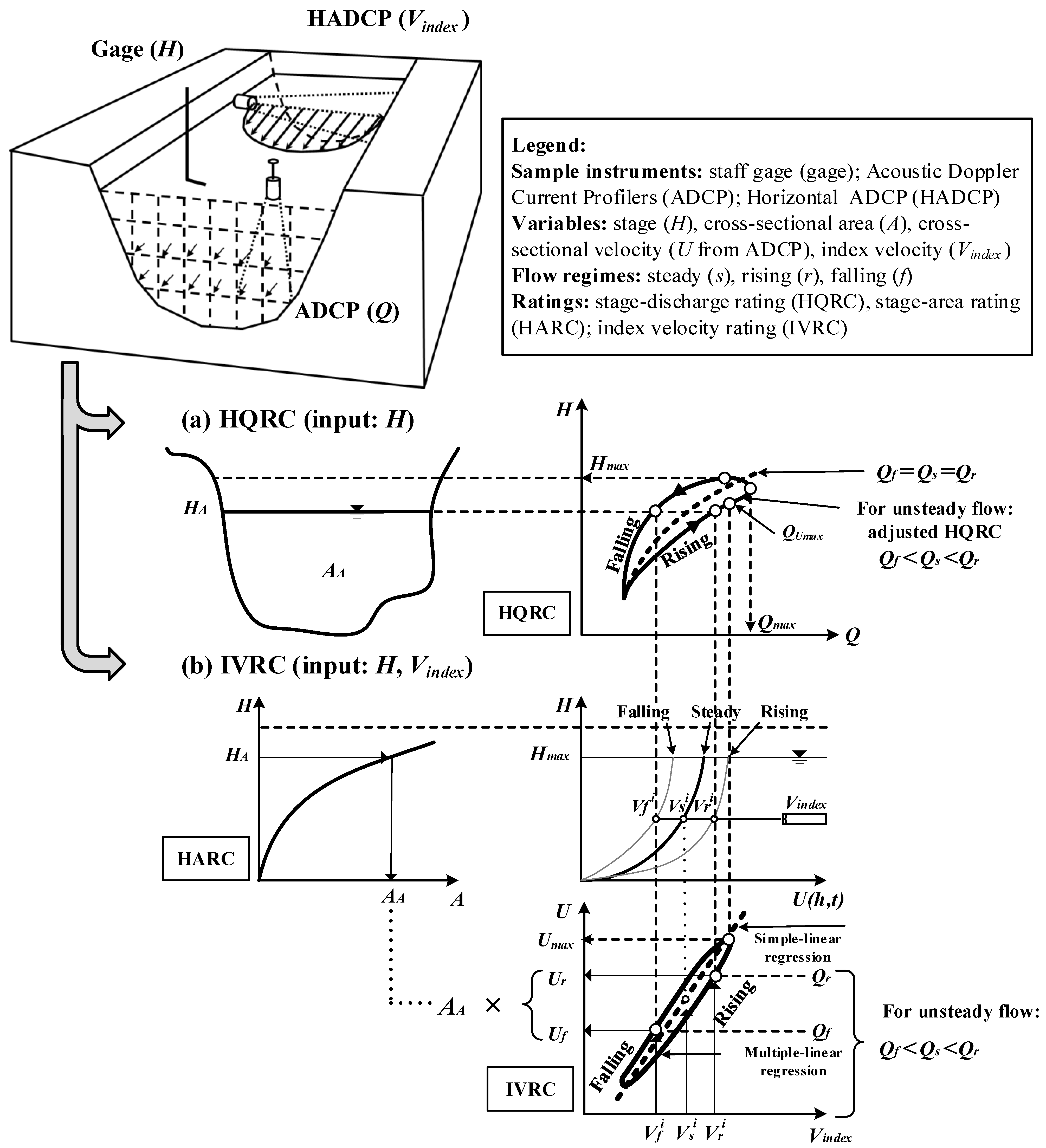
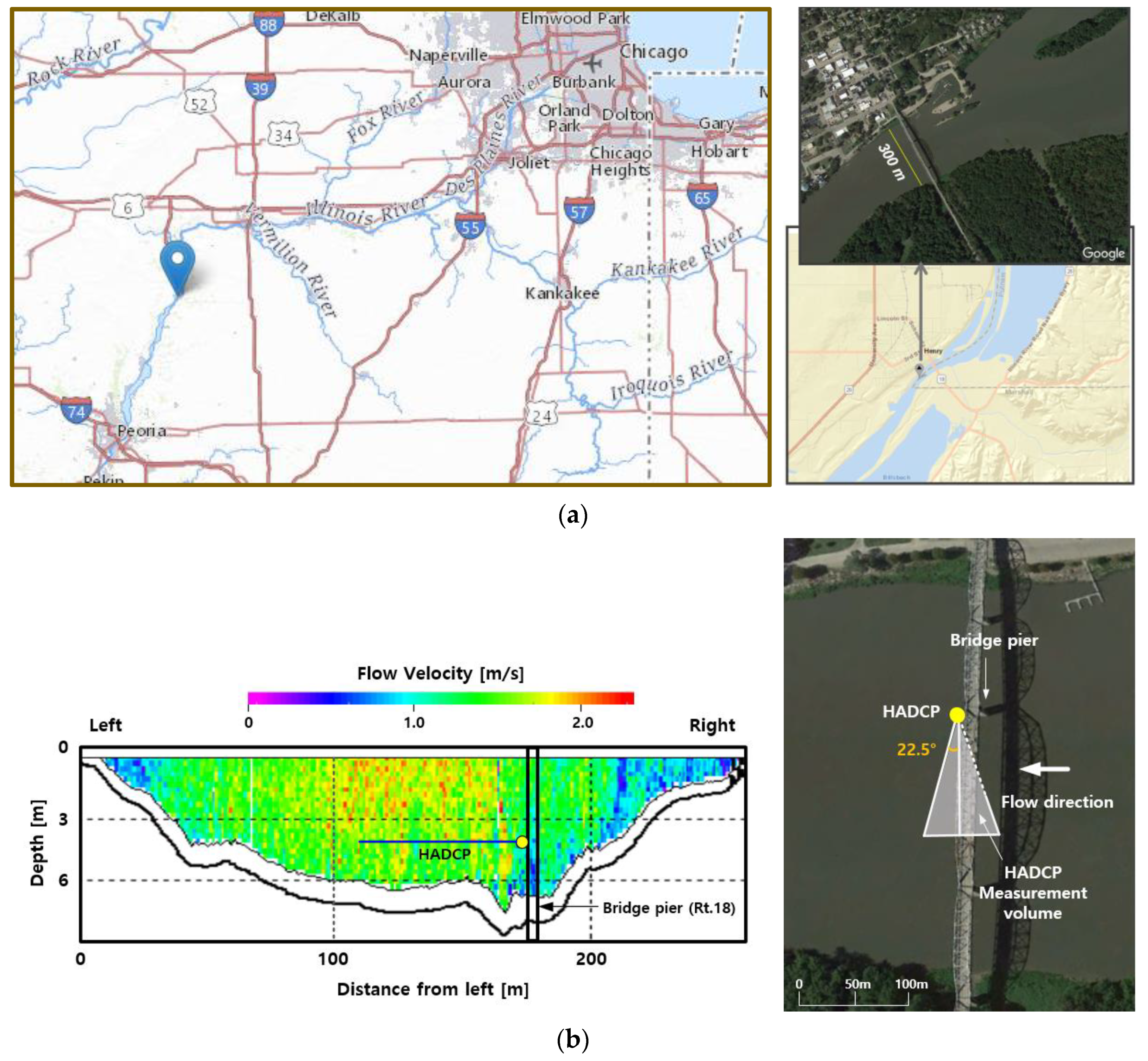
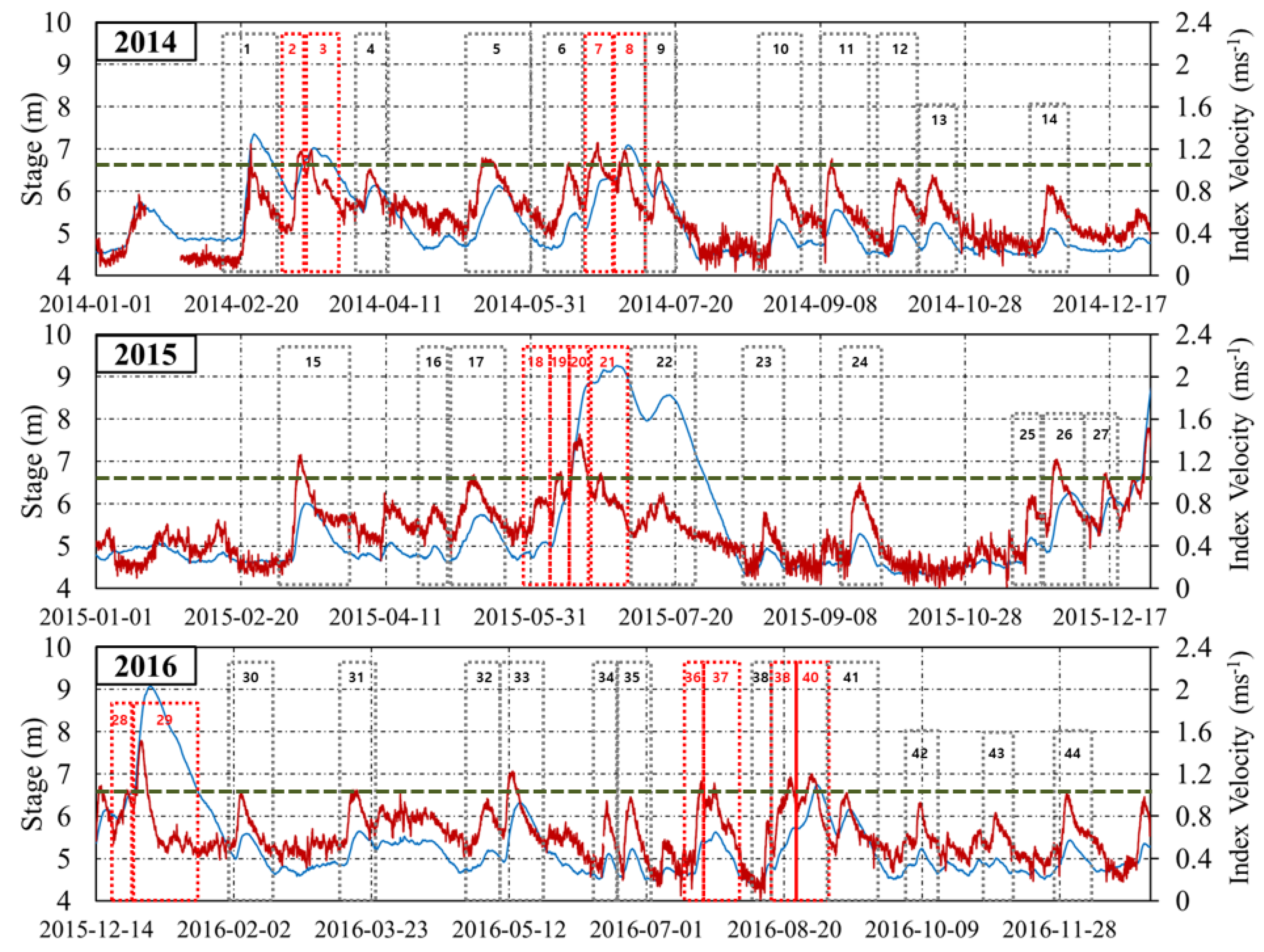
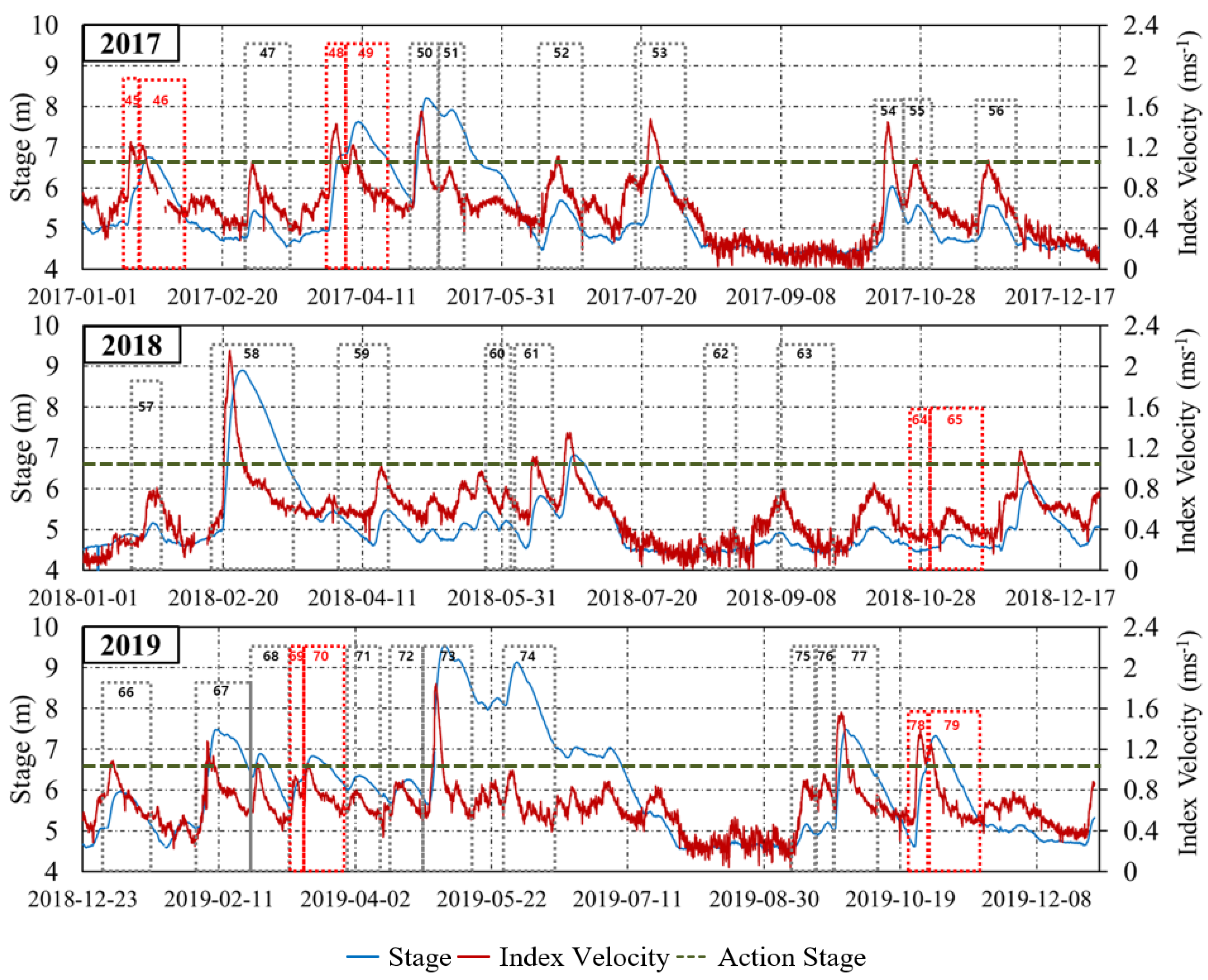
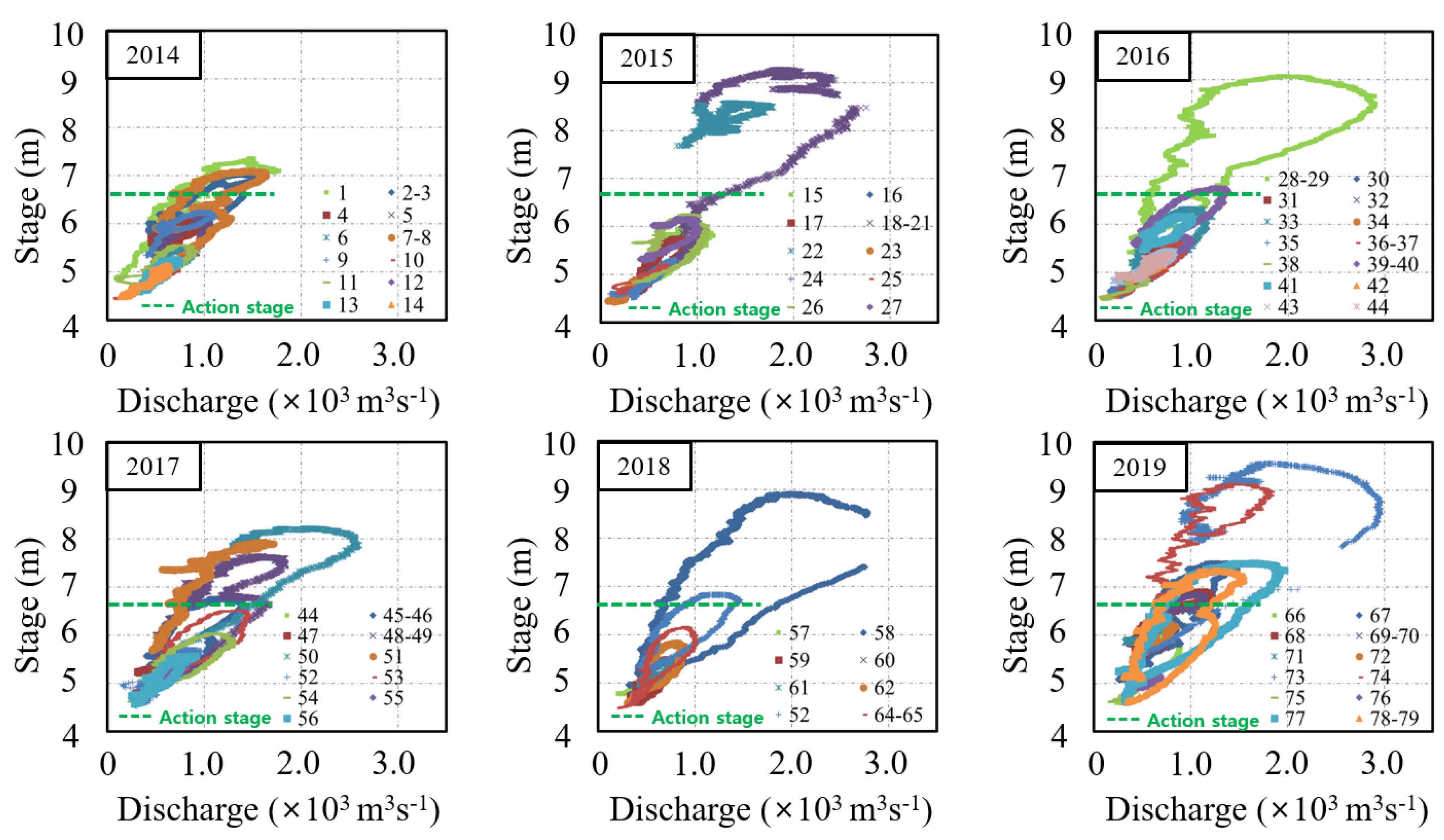
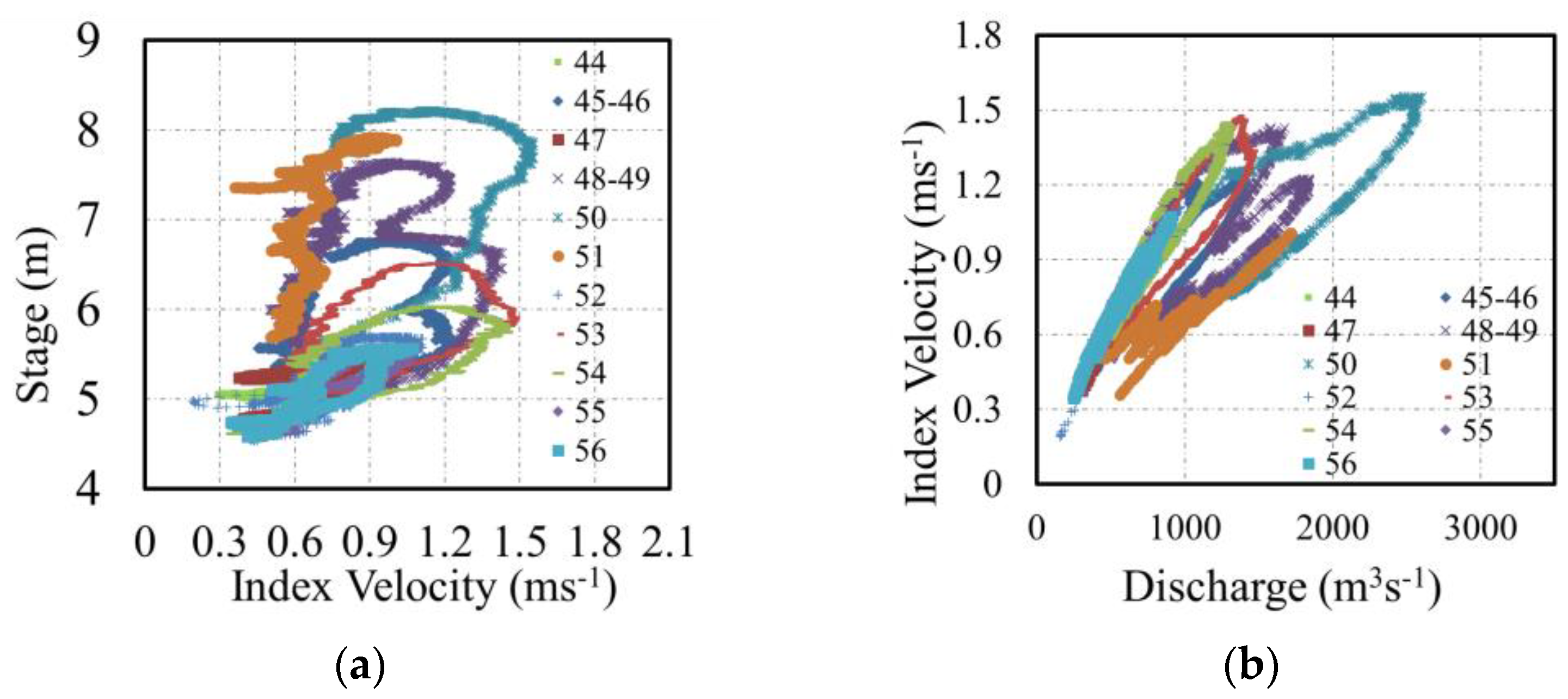
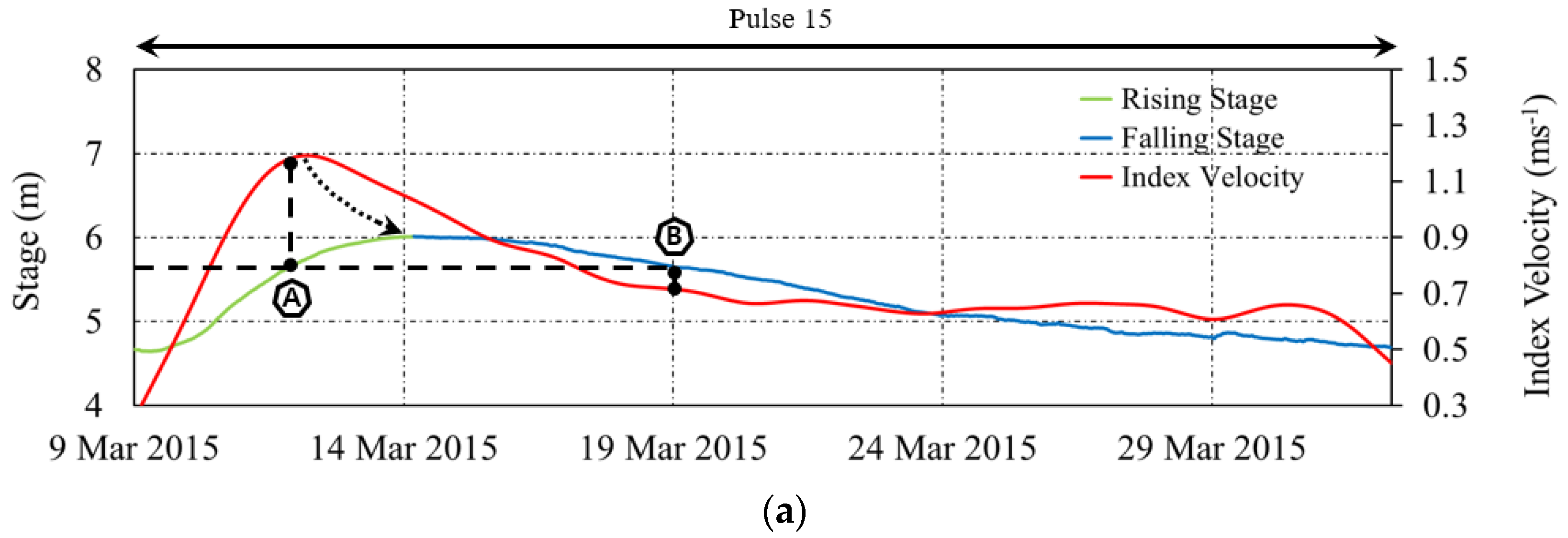
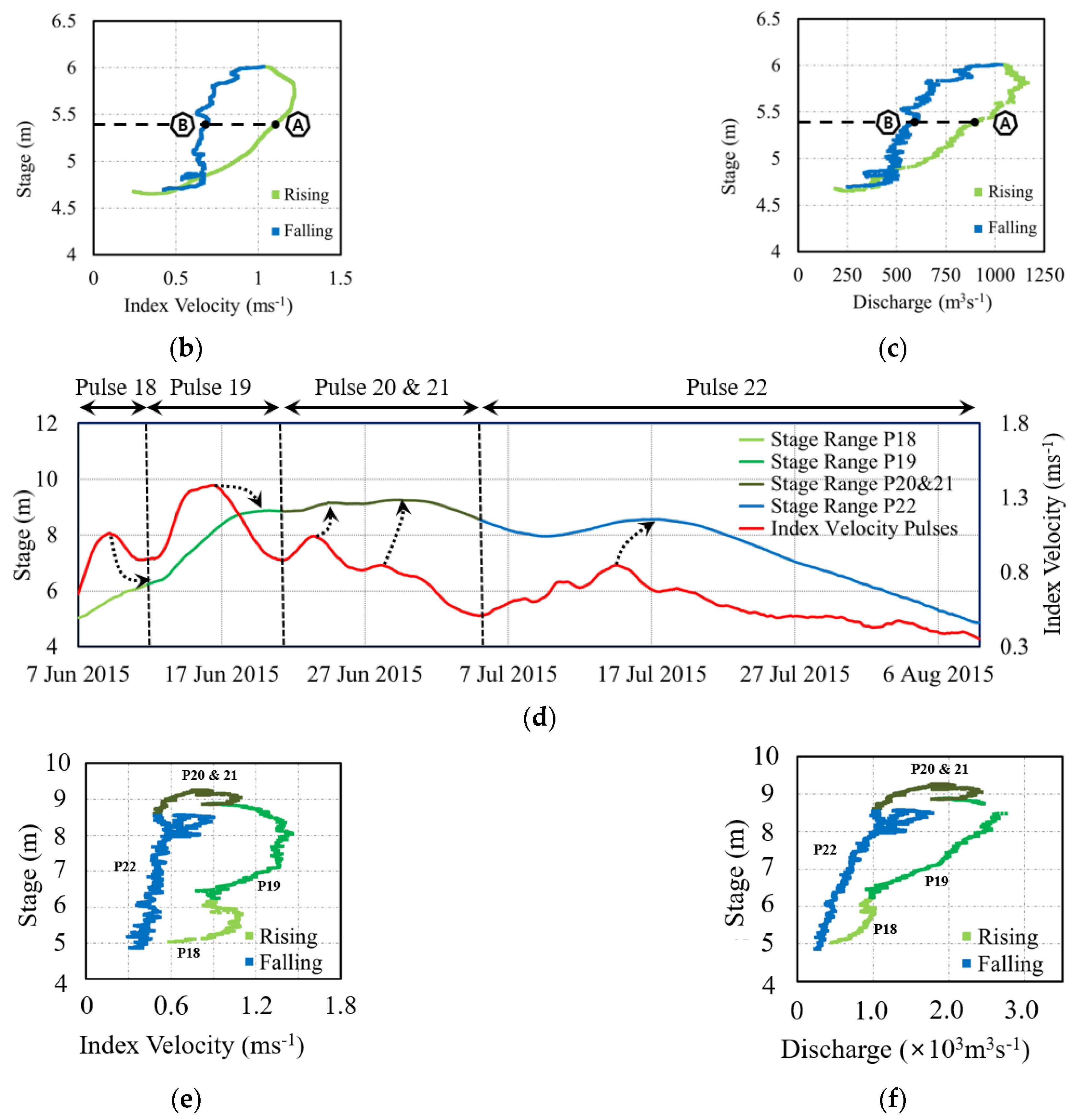

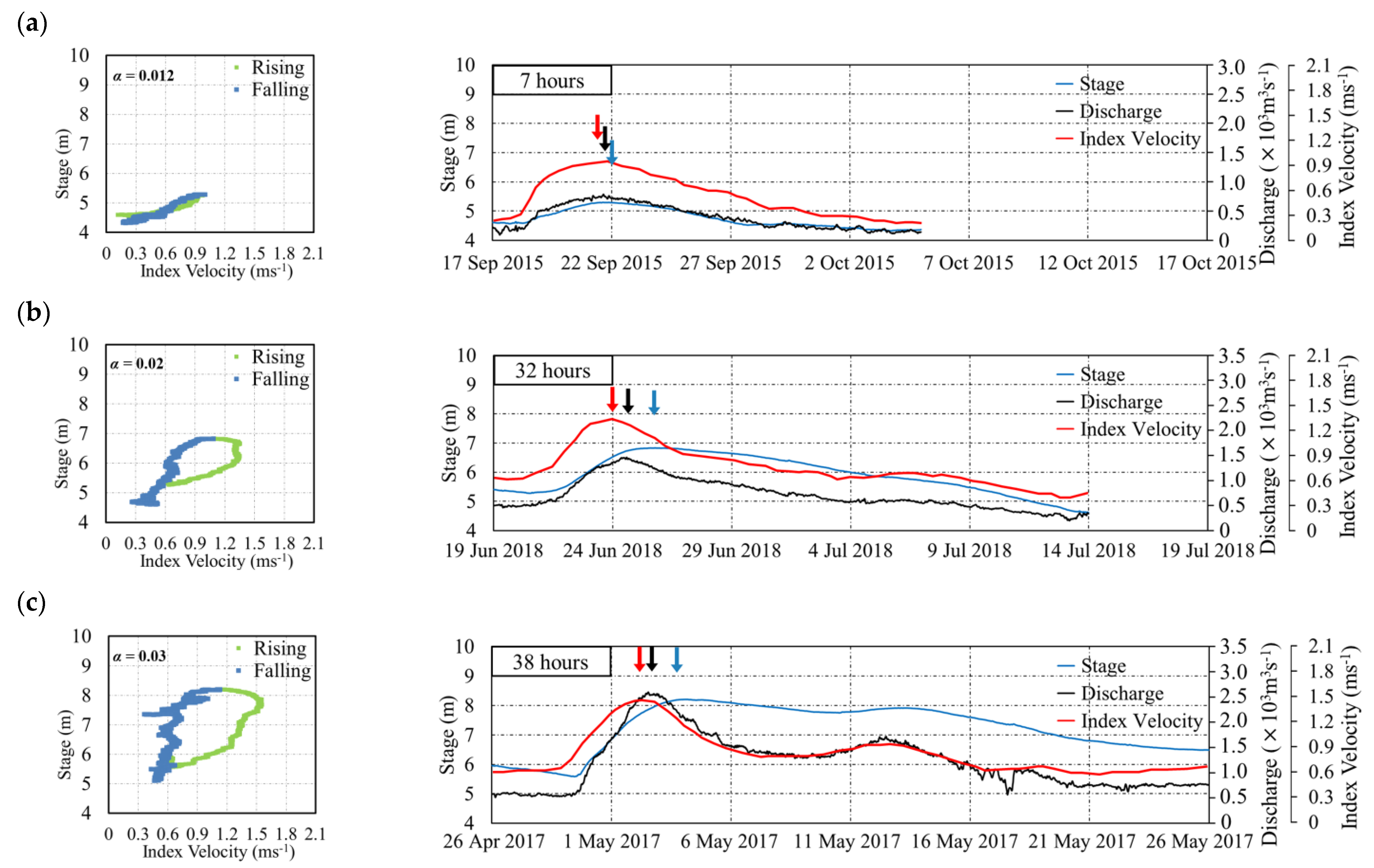
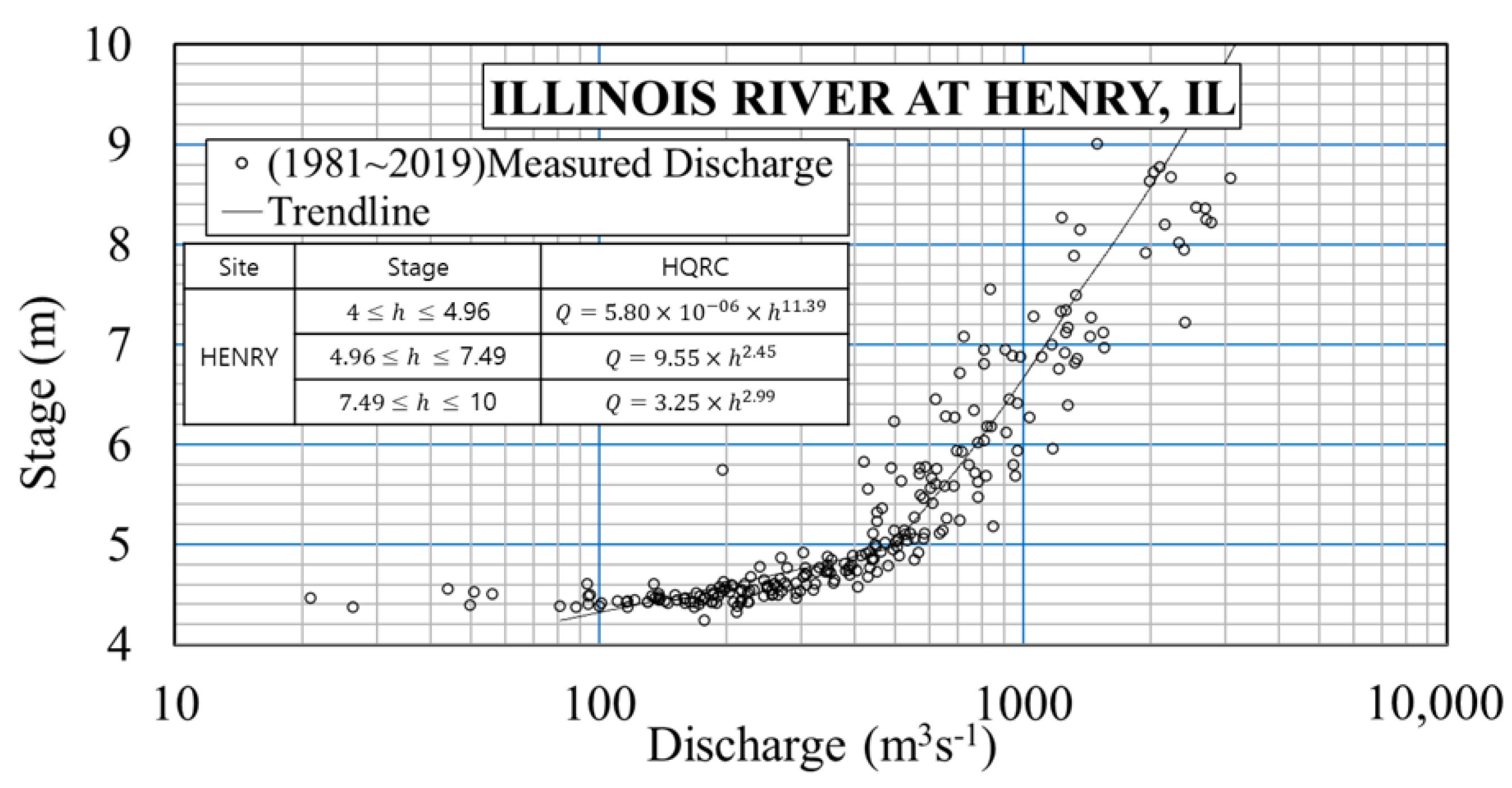
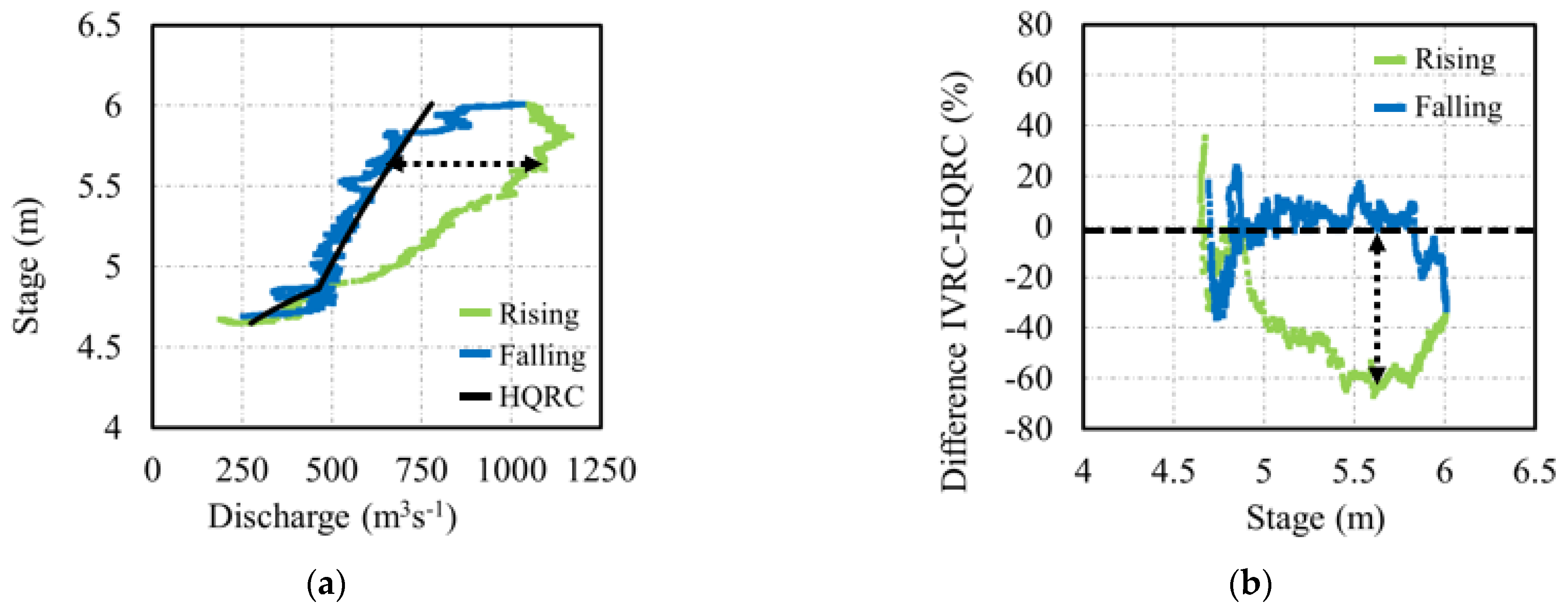


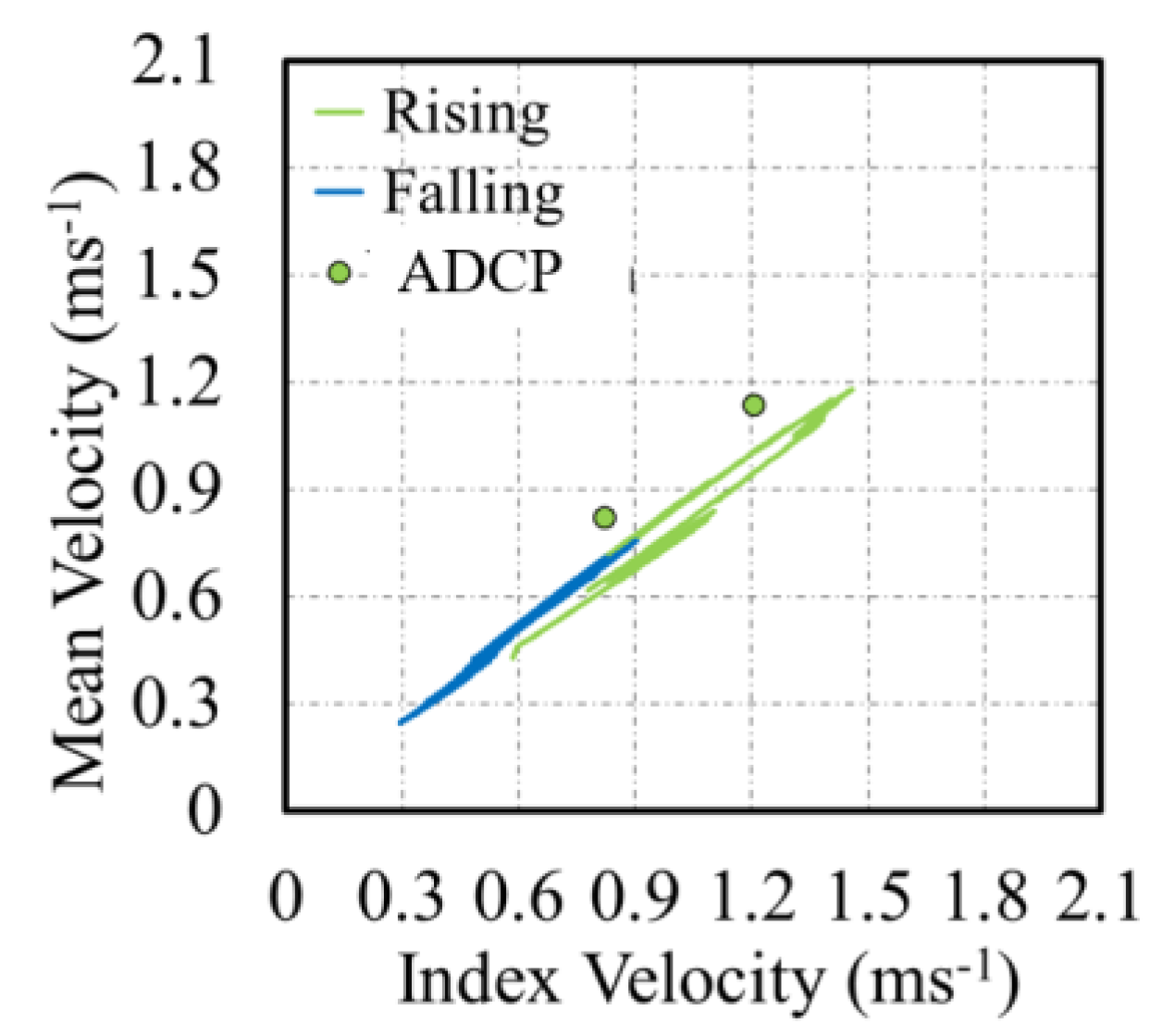
| Station | Regression Equation (x1—Stage; x2—Index Velocity, ENU) | Rating Validity | Maximum | |
|---|---|---|---|---|
| Discharge (m3s−1) | Stage (m) | |||
| Henry (USGS #05558300) | y = (x2 × 0.571) + (0.008 × x1 × x2) + 0.083 | 6/2015–2/2018 | 4560 | 9.95 |
| y = (x2 × 0.669) + 0.116 | 2/2018 to date | |||
| Year | Storm Event & Time Interval | Max. Discharge (m3s−1) | Max. Stage (m) | Max. Index Velocity (ms−1) |
|---|---|---|---|---|
| 2017 | 45–46 (16 January; 19:45~7 February; 08:00) | 1415 | 6.75 | 1.20 |
| 47 (28 February; 09:30~11 March; 16:45) | 864 | 5.43 | 1.00 | |
| 48–49 (29 March; 19:45~29 April; 11:00) | 1842 | 7.61 | 1.38 | |
| 50 (29 April; 11:00~11 March; 16:45) | 2599 | 8.20 | 1.51 | |
| 52 (15 June; 01:00~1 July; 11:15) | 968 | 5.68 | 1.06 | |
| 53 (19 July; 21:30~10 August; 11:15) | 1455 | 6.49 | 1.45 | |
| 54 (13 October; 00:45~23 October; 11:00) | 1299 | 6.00 | 1.39 | |
| 56 (17 November; 01:00~1 December; 23:00) | 911 | 5.55 | 0.95 |
Publisher’s Note: MDPI stays neutral with regard to jurisdictional claims in published maps and institutional affiliations. |
© 2022 by the authors. Licensee MDPI, Basel, Switzerland. This article is an open access article distributed under the terms and conditions of the Creative Commons Attribution (CC BY) license (https://creativecommons.org/licenses/by/4.0/).
Share and Cite
Muste, M.; Kim, D.; Kim, K. Insights into Flood Wave Propagation in Natural Streams as Captured with Acoustic Profilers at an Index-Velocity Gaging Station. Water 2022, 14, 1380. https://doi.org/10.3390/w14091380
Muste M, Kim D, Kim K. Insights into Flood Wave Propagation in Natural Streams as Captured with Acoustic Profilers at an Index-Velocity Gaging Station. Water. 2022; 14(9):1380. https://doi.org/10.3390/w14091380
Chicago/Turabian StyleMuste, Marian, Dongsu Kim, and Kyungdong Kim. 2022. "Insights into Flood Wave Propagation in Natural Streams as Captured with Acoustic Profilers at an Index-Velocity Gaging Station" Water 14, no. 9: 1380. https://doi.org/10.3390/w14091380
APA StyleMuste, M., Kim, D., & Kim, K. (2022). Insights into Flood Wave Propagation in Natural Streams as Captured with Acoustic Profilers at an Index-Velocity Gaging Station. Water, 14(9), 1380. https://doi.org/10.3390/w14091380







